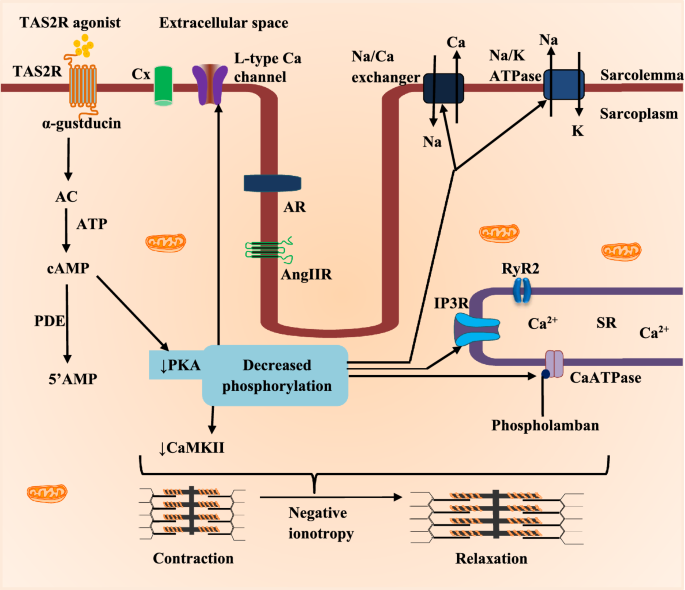Figures and data in Bitter taste receptors confer diverse
Por um escritor misterioso
Last updated 08 abril 2025

Insects and other animals use their sense of taste to tell if their food is safe to eat. Plant toxins, for example, often have a bitter flavor that animals can detect and avoid. Fruit flies have many bitter-sensitive nerve cells, but it is not known how the receptors on these nerve cells signal the detection of bitter-flavored compounds. Delventhal and Carlson have now used fruit flies to investigate how taste receptors of the so-called Gustatory receptor family detect bitter flavors. The experimental approach involved genetically modifying four different types of nerve cells that sense bitter compounds so that they produced higher levels of particular taste receptors than normal. Then, the flies were exposed to a range of bitter compounds while the electrical activity of each cell was measured. The analysis involved about 600 combinations of receptors, nerve cells and compounds. In some bitter-sensing nerve cells, increasing the number of taste receptors increased the cell’s responsiveness to bitter compounds. However, in other nerve cells, similar modifications suppressed an existing response or resulted in a new response. Delventhal and Carlson propose that these results suggest the specific response of a bitter-sensing nerve cell depends on the interactions between its different taste receptors. Furthermore, the ability of receptors to compete, inhibit or activate each other in different ways could have implications for evolution. For example, such flexible interactions might allow a taste system to evolve new, enhanced or diminished responses to new food sources and tastes in a changing environment. It now remains to be investigated how such receptor interactions take place at a molecular level.
Expression of Drosophila bitter receptors in taste neurons produced increased, decreased, or novel responses, supporting a model in which the response profile is determined by activation, inhibition, or competition among receptors.
Expression of Drosophila bitter receptors in taste neurons produced increased, decreased, or novel responses, supporting a model in which the response profile is determined by activation, inhibition, or competition among receptors.

Nutrients, Free Full-Text

Bitter taste receptors confer diverse functions to neurons

Heterogeneity in the Drosophila gustatory receptor complexes that detect aversive compounds

The Bitter Taste Receptor TAS2R16 Achieves High Specificity and Accommodates Diverse Glycoside Ligands by using a Two-faced Binding Pocket

Frontiers Independent Evolution of Strychnine Recognition by Bitter Taste Receptor Subtypes

The role of bitter and sweet taste receptors in upper airway innate immunity: Recent advances and future directions - ScienceDirect

Summary of receptors for umami, sweet, bitter and sour tastes.Schematic

Cellular mechanisms and molecular pathways linking bitter taste receptor signalling to cardiac inflammation, oxidative stress, arrhythmia and contractile dysfunction in heart diseases

Bitter Taste Receptors

Receptors, Free Full-Text

Bitter or not? BitterPredict, a tool for predicting taste from chemical structure

Cells, Free Full-Text

Frontiers A Matter of Taste: Lineage-Specific Loss of Function of Taste Receptor Genes in Vertebrates
Recomendado para você
-
 Pokemon Type Chart by AdeptCharon on DeviantArt08 abril 2025
Pokemon Type Chart by AdeptCharon on DeviantArt08 abril 2025 -
 Pokemon Type Chart - Combinations Updated (Gen 9) by Loran-Hemlock on DeviantArt08 abril 2025
Pokemon Type Chart - Combinations Updated (Gen 9) by Loran-Hemlock on DeviantArt08 abril 2025 -
 YetiFrood on X: My Super Readable EZ GG Effectiveness Type Chart08 abril 2025
YetiFrood on X: My Super Readable EZ GG Effectiveness Type Chart08 abril 2025 -
 Mobile-friendly type effectiveness chart (with updated resistances08 abril 2025
Mobile-friendly type effectiveness chart (with updated resistances08 abril 2025 -
 Pin on Products08 abril 2025
Pin on Products08 abril 2025 -
 The CORRECT type chart.08 abril 2025
The CORRECT type chart.08 abril 2025 -
 IJGI, Free Full-Text08 abril 2025
IJGI, Free Full-Text08 abril 2025 -
 I made a type chart08 abril 2025
I made a type chart08 abril 2025 -
 pokemon emerald but the type chart is this amogus [patch in08 abril 2025
pokemon emerald but the type chart is this amogus [patch in08 abril 2025 -
 Pokémon VG Type Info Pokémon Aaah! The Website - Pokémon Aaah! The Website08 abril 2025
Pokémon VG Type Info Pokémon Aaah! The Website - Pokémon Aaah! The Website08 abril 2025
você pode gostar
-
 Brotherhood by SkyleWolf on deviantART Devil may cry, Dante devil may cry, Devil may cry 408 abril 2025
Brotherhood by SkyleWolf on deviantART Devil may cry, Dante devil may cry, Devil may cry 408 abril 2025 -
GTA San Andreas DINHEIRO INFINITO GRÁTIS 2023 v2.10 APK08 abril 2025
-
 Lista de códigos promocionais Garena Free Fire - Alucare08 abril 2025
Lista de códigos promocionais Garena Free Fire - Alucare08 abril 2025 -
 old gacha oc by alexluvsskittlez on Newgrounds08 abril 2025
old gacha oc by alexluvsskittlez on Newgrounds08 abril 2025 -
 Jogo Brothers In Arms: Hell's Highway - PS3 - Comprar Jogos08 abril 2025
Jogo Brothers In Arms: Hell's Highway - PS3 - Comprar Jogos08 abril 2025 -
 Shijou Saikyo no Deshi Kenichi Gaiden+Plus+Guide+Tatakae Ryozanpaku 1-5 Japanese08 abril 2025
Shijou Saikyo no Deshi Kenichi Gaiden+Plus+Guide+Tatakae Ryozanpaku 1-5 Japanese08 abril 2025 -
 GTA 6 trends on Twitter again; spawns hilarious memes ft The Weekend08 abril 2025
GTA 6 trends on Twitter again; spawns hilarious memes ft The Weekend08 abril 2025 -
 Topo De Bolo Carros Personalizado Com Nome E Idade08 abril 2025
Topo De Bolo Carros Personalizado Com Nome E Idade08 abril 2025 -
 ROBLOX-Colar do mundo virtual periférico do jogo para crianças08 abril 2025
ROBLOX-Colar do mundo virtual periférico do jogo para crianças08 abril 2025 -
 Discuss Everything About Adopt Me! Wiki, Fandom in 202308 abril 2025
Discuss Everything About Adopt Me! Wiki, Fandom in 202308 abril 2025